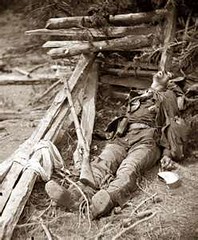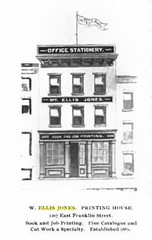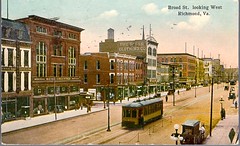This is a transcription of an article that first appeared in a Louisburg, North Carolina newspaper article, June 25, 1943.
Slave Account – Isham Crews, born into slavery; the property of either the Hunts or the Wrights in Franklin County, was transferred to Tar River Plantation and the control of “Mist’ Jimmie Crews” about 1845.
Washington could use a man like Isham Crews, 96 year-old ex-slave who’s living through his fourth American war.
The aged Franklin County Negro speaks cautiously, sometimes pausing a second in the middle of a sentence, but he goes directly to the point.
“Trouble with these times,” he says, “is that some people need to be made to work.”
Isham could tell the occupied countries a thing or two about hiding valuables, food, and livestock. He vividly remembers when ‘de Yankee’s’ came through North Carolina.
He was born in Franklin County, a Wright, and taken to Granville County at the age of six weeks. His mother’s young mistress, Martha Wright, married “Mist’ Jimmy Crews” and thereby Isham, whose mother and other Negroes were given the young bride by her father, became a Crews.
[Ed Note: James A. “Jimmy” Crews wife was actually Martha Hunt, from Person County, North Carolina. They were married on August 11, 1834. Isham would have been 109 years-old when he gave this interview, if he actually came to the farm with his mothers’ “young mistress” – which isn’t entirely out of the question.]
He was sixteen when Sherman’s army came through the state. His master’s wheat was hidden in a large hollow column on the porch, the silver and gold placed in a large iron pot and buried, and the mules hidden in a swamp bottom.*
[Ed. Note: If Isham came to farm at six weeks old in 1834, then he would have been about 31 years old when Sherman’s army came and camped on the farm in the spring of 1865. What is much more likely is that Isham came to the farm with a bride of one of James A. Crews’ children – though none of those women were “Wright’s” by maiden name, and the dates don’t jibe – or arrived another way entirely (recall that he was just six weeks old when he was transferred.) If he was sixteen when Sherman came, this would place his date of birth about 1849, which would have made him about sixteen or seventeen when Sherman marched though, and about 96 years old when he gave the interview. He reported his age at the time as 96 years old.]
Before the army came through, groups of men “came and sneaked aroun’, bought food from us and gave us silver money to tell where the master hid his things.” Isham said.
They took the money, but never told anything, except one man who told where the mules were hidden, Isham added. Then, chuckling, he recalled “that money won’t no good.”
He still has one of the pieces of money, a Spanish coin minted in 1737.
The Yankee’s took all of his master’s mules except one blind one, Isham said, and pulled up everything that was growing. They raided the corn crib and confiscated all the chickens, cows, and pigs.
Some of the slaves went freely with the Yankees, he said, while others stayed on with their masters. Isham stayed.
Negroes were sent to the “bressel” (breast) works, built to keep the Yankees from “stealin’” the white children, and in many instances Negroes were hidden in underground passage ways and fed for months by their masters to “keep the Yankees from gittin’ them.”
Isham said that “in the old days” the slaves had houses built in rows back of the master’s house. Every woman had to spin three pounds of cotton each night, except Saturday night, at which time all the children’s clothes were washed. Each child had two long shirts for summer and two for winter, but had no shoes (no 18 stamps, possibly). Only the grown-ups had shoes – the men’s had wooden soles, the women’s all leather.
The men, of course, worked in the fields.
No baths were ever given or heads combed, only among the “favorite” children, Isham recalled. The children were fed 12 at a time out of a trough dug out of a tree trunk. “Mushroom” shells (apparently mussel) were used by each child to eat peas and beans with and each child had a gourd dipper to drink from. The food was mostly pot-liquor, corn bread, peas, turnip salad and meat skins.
The slaves couldn’t go from one plantation to another without a “furlough” because the patteroes” would punish them. The “patteroes”, Isham explained, were poor white people hired by the plantation owners apparently as guards or patrols. The slaves and patteroes seemed to have a healthy dislike for each other, because Isham smilingly recalled that the Negroes would string grape vines across the road to trip the patteroes’ mules.
His master treated the slaves pretty well, Isham said, and never whipped them much – because his wife wouldn’t let him. He never sold any of them, either. In fact, he couldn’t, as they were owned by his wife.
Isham said that the flat woodland in Granville County had never been hunted, so when he was 14 he begged permission of his master to allow him to go hunting. Permission granted, Isham set out, taking his master’s young son, Edgar, with him. (Ed. Note: Edgar Crews was the son of David Goodman Crews and his wife, Louisa Flemming Crews. They married in 1866 and Edgar was born in 1867, when Isham would have been about seventeen. If Edgar was old enough to ride along (perhaps four years old), this would have put Isham at 21 years old.) Despite having to carry Edgar seated astraddle his neck, Isham returned to the plantation with two ‘possums.
After that, his master gave him two dogs and allowed him to go hunting regularly – the master apparently agreeing with those who think ‘possum and sweet potatoes can’t be beat.
Isham, who’s pretty spry for a young lad of 96, spends most of his time sitting in the shade these hot days. He doesn’t have much to say about this new war – the real fight was in the 1860’s as far as he’s concerned.
But times are worse now, he says. He still thinks there are too many people who “need to be made to work”.
—————————–
[Ed Notes:
1. Many of the dates and names associated with this account do not add up, and I have made notes in content where I find factual conflict. That said, I feel strongly that the gist of his account is quite true, as I have heard similar recollections passed down through generational family lore. Where this occurs, I have noted the text with a “*”.
2. My source for this account is: “Granville County Heritage, North Carolina, Vol. I”, pp. 164 – 165. ©2002, Granville County Heritage Book Committee & County Heritage, Inc., located at the Richard H. Thornton Library, Oxford, North Carolina.
3. This account first appeared in the Louisburg newspaper, June 25, 1943, and may have appeared simultaneously on the same date in the Raleigh, News and Observer; although I have been unable to verify this. My belief is based upon a reference to this slave account in a biography of James A. Crews and his Wife Martha Ann Hunt Crews that appears in “Granville County Heritage”, on page 165.]
UPDATE 12/10/2013:
My cousin, Dan (who is a far better researcher than me!) read my blog post and then came up with a death certificate for one Isham Crews, of Franklin County, N.C. This document clarifies a lot of the details that didn’t quite synch in the original article. So let’s set the record straight in regards to Isham Crews age and how/when he came to Tar River Plantation.
Isham Crews was born on July 22, 1847. He was not yet born when Martha Hunt married Jimmie Crews in 1834. It’s likely that Isham’s mother, Jennie Hunt, belonged to Martha’s father, David Hunt, and was transferred to Martha shortly before Isham was born. Isham would have been eighteen years old when Sherman’s Army marched through Granville County and camped out on the plantation. He would have been almost ninety-six years old when he gave this interview in 1943. Isham Crews died on August 30, 1950, at the age of 103 years old.













You must be logged in to post a comment.